Having hit a home run with the smaller Galaxy S8, is Samsung’s Galaxy S8+ the bigger-screen phone to beat?
The Galaxy S8 and S8+ are practically identical metal and glass sandwiches, but the S8+ is 10.6mm taller, 5.3mm wider, 0.1mm thicker and 18g heavier than the S8, with a screen-to-body ratio of over 83%.
Like the S8, it is unusually tall for its width when compared to the competition (a radio of 18.5:9 rather than 16:9). At 73.4mm wide, S8+’s body is noticeably narrower than rivals despite having a larger 6.2in QHD+ screen. Compared to the 77.9mm wide iPhone 7 Plus, the S8+ is 4.5mm narrower, it’s 2.3mm narrower than the 75.7mm Google Pixel XL and 1.3mm narrower than the 74.7mm OnePlus 3T – all of which have 5.5in screens. The usual ratio means the S8+ is also taller than most of the competition, including the iPhone 7 Plus, being 159.5mm from top to bottom.
This means the top of the device is almost unreachable one-handed, though that isn’t too much of an issue most of the time thanks to some clever software. The bigger problem for some will be physically fitting it in a pocket. In some men’s straight Gap jeans, which have relatively generous pockets, the top of the phone is almost uncomfortably close to poking out. If you wear tighter jeans or trousers with smaller pockets you may find the S8+ just too tall.
The best screen. Full stop.

The display of the S8+ is, frankly, epic. At 6.2in it’s one of the biggest screens available on a top-end smartphone and with its inky blacks, rich colours and large range of brightness, it shines in almost any condition. Watching HDR video is particularly luscious, and the screen is big enough to make you question whether a tablet’s really needed.
Like the S8, the S8+ is set to the equivalent of full HD resolution, not the full QHD+ resolution the display is capable of showing. Users can switch between QHD+, FHD+ and a 720p equivalent to save battery life at the detriment of display crispness.
The home button is now virtual with a pressure-sensitive spot on the screen, acting as both a software and hardware button in one. Samsung’s usual capacitive back and recent apps buttons are now also virtual, in line with most other Android devices.
The S8+ is water resistant to depths of 1.5m for 30 minutes with an IP68 rating, and Corning’s Gorilla Glass 5, which should hopefully make both front and back more scratch and shatter resistant.
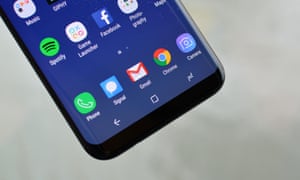
Specifications
- Screen: 6.2in quad HD+ AMOLED (529ppi)
- Processor: octa-core Samsung Exynos 8895 or octa-core Qualcomm Snapdragon 835
- RAM: 4GB of RAM
- Storage: 64GB + microSD card
- Operating system: Android 7.0 with TouchWiz
- Camera: 12MP rear camera with OIS, 8MP front-facing camera
- Connectivity: LTE, Wi-Fi, NFC, wireless charging, Bluetooth 5, GPS and Iris sensor
- Dimensions: 159.5 x 73.4 x 8.1 mm
- Weight: 173g
30+ hours battery life
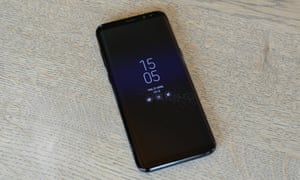
I tested the European Exynos 8895 version of the Galaxy S8. US Galaxy S8 buyers will get a version that uses a Qualcomm Snapdragon 835 instead.
The Galaxy S8+ has the same processor, same amount of RAM and same amount of storage as the S8 and behaves the same. The S8+ also supports the new cat 9 LTE – the fastest of 4G technologies currently available in large urban areas only through EE – and the brand new Bluetooth 5.0 standard, which will provide much more advanced and robust support for wireless headphones among other things in the near future.
The S8+ has a slightly larger battery than the S8 and it shows. Using it as my primary device, browsing and using apps for four hours with hundreds of push emails, 90 minutes of gaming, and listening to around five hours of music via Bluetooth headphones, the Galaxy S8+ lasted over 30 hours between charges. That was with the screen set to QHD+, the always-on display (AOD) active and no power-saving modes activated.
Setting the screen to FHD+ and turning off AOD the S8+ managed another 2-3 hours between charges, while the battery saving modes could easily make the S8+ last two days of fairly heavy use.
The S8, which has a slightly smaller battery, lasted just over 24 hours in a similar scenario.
TouchWiz
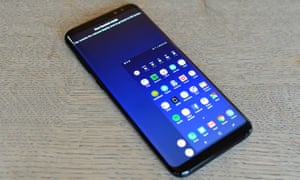
The S8+ runs the latest version of Samsung’s customised Android, TouchWiz, based on Android 7.0 Nougat, not the latest 7.1. It’s the same version as the S8. For more on TouchWiz, please see the Galaxy S8 review.
The bigger screen makes multi-window – where you have two apps side-by-side on the screen – more useful. Because the screen is so long, when landscape in multi-window mode, the apps are about the same width as the Galaxy S8’s screen, but they’re still a little pokey to use because they’re squat. I found it good for quick things or watching a video while replying to emails, but not much more than that.
One-handed mode, which shrinks the screen down to the left or right side of the phone, works well. Triple tap the home button or swipe in from the corner to activate it for when two hands aren’t available.
The S8+ also has Samsung’s new smart assistant called Bixby, which is designed as a Google Assistant or Siri rival, but isn’t quite as capable as Google Assistant.
The voice features aren’t available yet, the personalised news feeds, reminders and widgets aren’t any better than rivals, and the Bixby Vision object recognition is a bit hit and miss. Bixby may improve, but it doesn’t have access to quite as much data as rivals, which means it may struggle.
Biometrics

The S8+ has a fingerprint scanner, iris scanner and facial recognition built in for unlocking the phone and authenticating purchases.
As with the S8, the fingerprint scanner is placed on the back next to the camera, but now the device is much longer. Despite being used to phablets with fingerprint scanners on the back I found it initially awkward and unreliable. I got used to it after a few days, adjusting my default holding position higher up the phone, but it would be much better placed below the camera.
The iris scanner on the front is a good alternative to inputting a passcode or pattern to unlock the device, if you’re not in direct sunlight. It came in handy when the phone was flat on the desk, but it will struggle with glasses and contact lenses.
Cameras
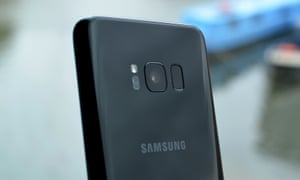
The S8+ has the same 12-megapixel rear and 8-megapixel selfie camera as the S8, which makes it one of the best on the market, particularly in poor lighting conditions.
S8+’s camera app is one of the best available with a new floating shutter button making selfies and one-handed photos much easier on the large device – put it where you can reach and not drop your phone while trying to get the perfect snap.
Observations
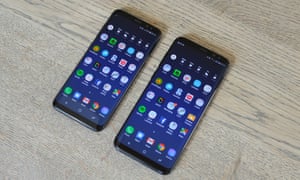
- There’s a notification LED that can be set to flash for various events
- The S8 supports HDR video including that from Amazon Video
- You can play the sound from two apps to two different devices at the same time, such as music to a Bluetooth speaker and game audio through the built-in speaker
- The secure folder allows you to keep certain apps or duplicates of apps in a password or biometrically secured folder, handy for work-specific versions of apps you might want to use
- Gaming on the large, extra-wide S8+ is brilliant – your thumbs are tucked out the way of the main action in the middle of the screen
- The Adapt Sound function, which tunes audio using either a fully-custom sound profile or presets for people under 30, people over 30 and people over 60 actually made a surprising amount of difference (I’m over 30)
- There was no red tint or any other issue visible
Price
The Samsung Galaxy S8 costs £779 with 64GB of storage in black or grey due to ship on 28 April.
For comparison, Google’s Pixel XL costs £719 with 32GB of storage, Apple’s iPhone 7 Plus costs £719 with 32GB of storage, the LG G6 costs £649 with 32GB of storage, the OnePlus 3T costs £399 with 64GB of storage and the Huawei P10 Plus costs £649 with 128GB of storage.
Verdict
There are two reasons to buy the Galaxy S8+ – an epic screen and solid battery life. Everything else is pretty much the same as the smaller S8, but it’s more awkward to hold and carry.
There’s no doubt it’s a great phone that’s practically unrivalled on the display front. Samsung has done a fantastic job of shrinking the rest of the device down, and it’s still more manageable than the tired designs used by some rivals, but I think a 6.2in screen is a stretch too far.
The S8+ is the king of massive phones, but it’s just not quite the best smartphone available.
Pros: 64GB + microSD card slot, wireless charging, IP68, brilliant screen, good battery life, great camera, iris scanner, pressure-sensitive screen, notification LED
Cons: fixed battery, only Android 7.0, no USB-PD, fingerprint scanner placement not great



Be the first to comment